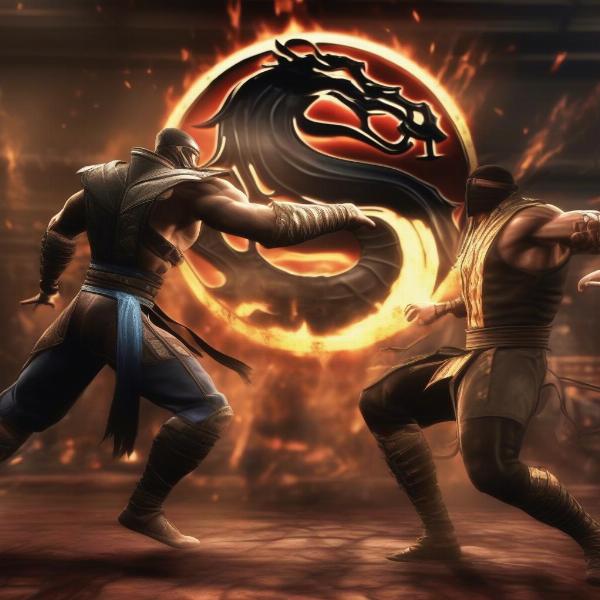The question of “What Is The Most Violent Video Game” is complex and often debated. Violence in video games is subjective and depends on individual interpretations. What one person finds disturbing, another might dismiss. However, we can explore some of the most frequently cited titles and delve into the factors that contribute to their reputation for violence.
Exploring the Contenders for Most Violent Video Game
Several games consistently appear in discussions about extreme violence. These include titles like Mortal Kombat, Manhunt, and Postal. Each of these games features graphic depictions of violence, often pushing the boundaries of what’s considered acceptable in mainstream media. Mortal Kombat, for instance, is notorious for its fatalities, elaborate finishing moves that showcase brutal and over-the-top violence. Manhunt, on the other hand, focuses on stealth kills and brutal executions, creating a disturbingly realistic atmosphere of violence. Postal, meanwhile, is known for its darkly comedic and often gratuitous violence.
Factors Contributing to Perceived Violence
The perception of violence isn’t solely based on the amount of blood and gore. Context, narrative, and player agency also play significant roles. A game with a compelling story that explores the consequences of violence can be perceived differently than a game that glorifies gratuitous violence without any narrative depth. Player agency, or the ability to choose how to interact with the game world, is another important factor. If players are forced to commit violent acts, it can create a more disturbing experience than if they have the option to choose a non-violent path.
 Mortal Kombat Fatality Scene Analysis: Exploring Violence in Gaming
Mortal Kombat Fatality Scene Analysis: Exploring Violence in Gaming
The Impact of Technology on Depicting Violence
As technology advances, so too does the ability to depict violence in video games. Realistic graphics and improved physics engines can make violence appear more visceral and impactful. This raises questions about the potential psychological effects of exposure to such graphic content. While research in this area is ongoing and often yields mixed results, it’s an important consideration in the ongoing discussion about violent video games. Some researchers argue that exposure to violent video games can desensitize individuals to violence, while others maintain that there is no direct causal link between video game violence and real-world aggression.
The Role of Ratings and Regulations
Organizations like the ESRB (Entertainment Software Rating Board) provide age ratings for video games, aiming to inform consumers about the content they are purchasing. These ratings take into account factors like violence, language, and sexual content. While these ratings are a useful tool, they are not without their limitations. Ultimately, parents and individuals must make informed decisions about what content they deem appropriate.
 ESRB Rating System Explained: A Guide for Parents and Gamers
ESRB Rating System Explained: A Guide for Parents and Gamers
The Evolution of Violence in Video Games
From the pixelated violence of early arcade games to the photorealistic gore of modern titles, the depiction of violence in video games has undergone a dramatic transformation. This evolution reflects not only technological advancements but also changing societal attitudes towards violence in media. What was considered shocking and controversial a few decades ago might be commonplace today. Understanding this historical context is crucial when discussing the most violent video games.
“The context of violence is often more important than the depiction itself,” says Dr. Anya Sharma, a media psychologist specializing in the effects of video games. “A game that explores the consequences of violence can be a powerful tool for social commentary, while a game that glorifies violence for its own sake can be potentially harmful.”
 Evolution of Violence in Video Games: A Timeline from Pixels to Photorealism
Evolution of Violence in Video Games: A Timeline from Pixels to Photorealism
The Psychology of Violence in Games
Why are we drawn to violence in video games? This is a complex question with no easy answers. For some, it’s the thrill of competition and the satisfaction of overcoming challenges. For others, it can be a way to explore darker themes and emotions in a safe and controlled environment. Understanding the psychological motivations behind our fascination with violence is essential for navigating the complex ethical and social implications of violent video games.
“Video games offer a unique space for exploring complex themes, including violence,” adds Dr. Sharma. “It’s important to remember that these are fictional worlds, and engaging with violence in a game doesn’t necessarily translate to real-world aggression.”
Conclusion
Determining the single “most violent video game” is subjective and depends on individual interpretations. Factors such as graphic detail, context, player agency, and the overall tone of the game all contribute to the perception of violence. While games like Mortal Kombat, Manhunt, and Postal are frequently cited for their graphic depictions of violence, it’s important to consider the multifaceted nature of this issue. Ultimately, understanding the context and engaging in thoughtful discussions about the portrayal of violence in video games is more important than simply labeling one game as the “most violent.” What do you think? Share your thoughts and opinions in the comments below!
FAQ
-
What is the ESRB rating system? The ESRB is a self-regulatory organization that assigns age and content ratings to video games.
-
Do violent video games cause real-world violence? Research on this topic is ongoing and complex, with no definitive consensus.
-
What are some examples of games considered violent? Titles like Mortal Kombat, Manhunt, and Postal are often cited.
-
Why are some games more violent than others? Factors like narrative, context, and player agency all play a role.
-
How can I make informed decisions about violent video games? Consider ESRB ratings, reviews, and your own personal values.
-
What is the future of violence in video games? As technology advances, the depiction of violence will likely become even more realistic.
-
How can I discuss violent video games with my children? Open communication and education about media literacy are key.

